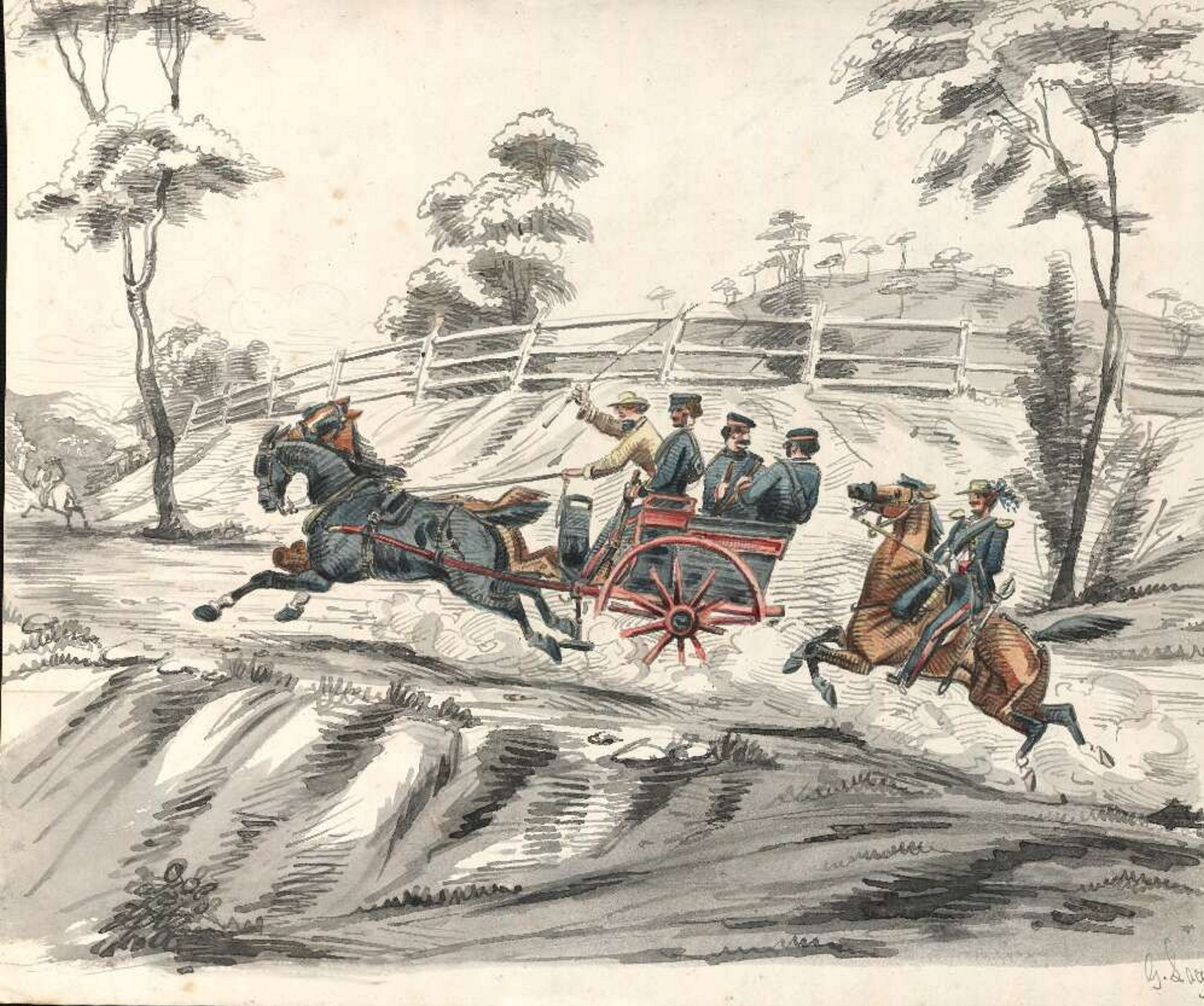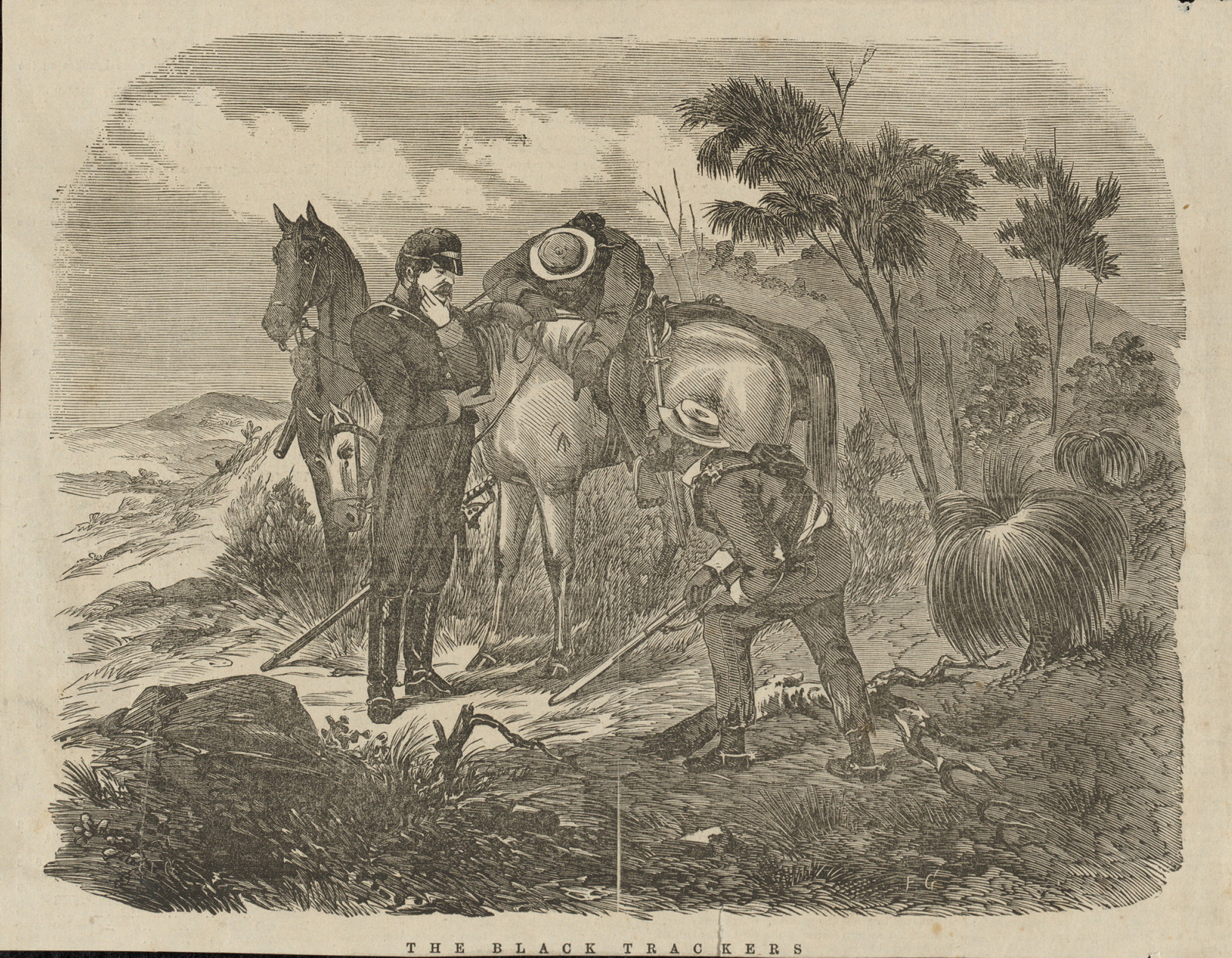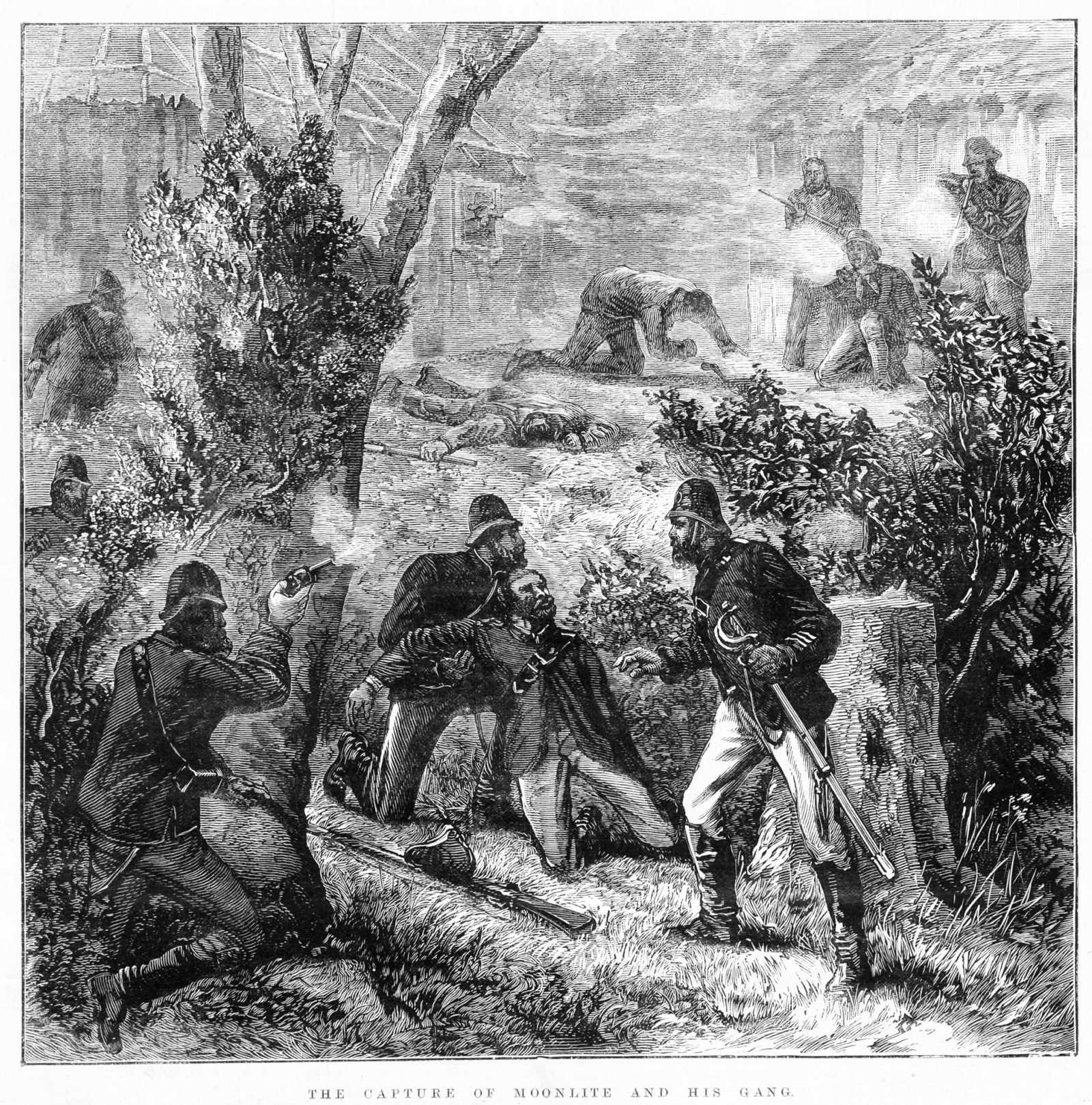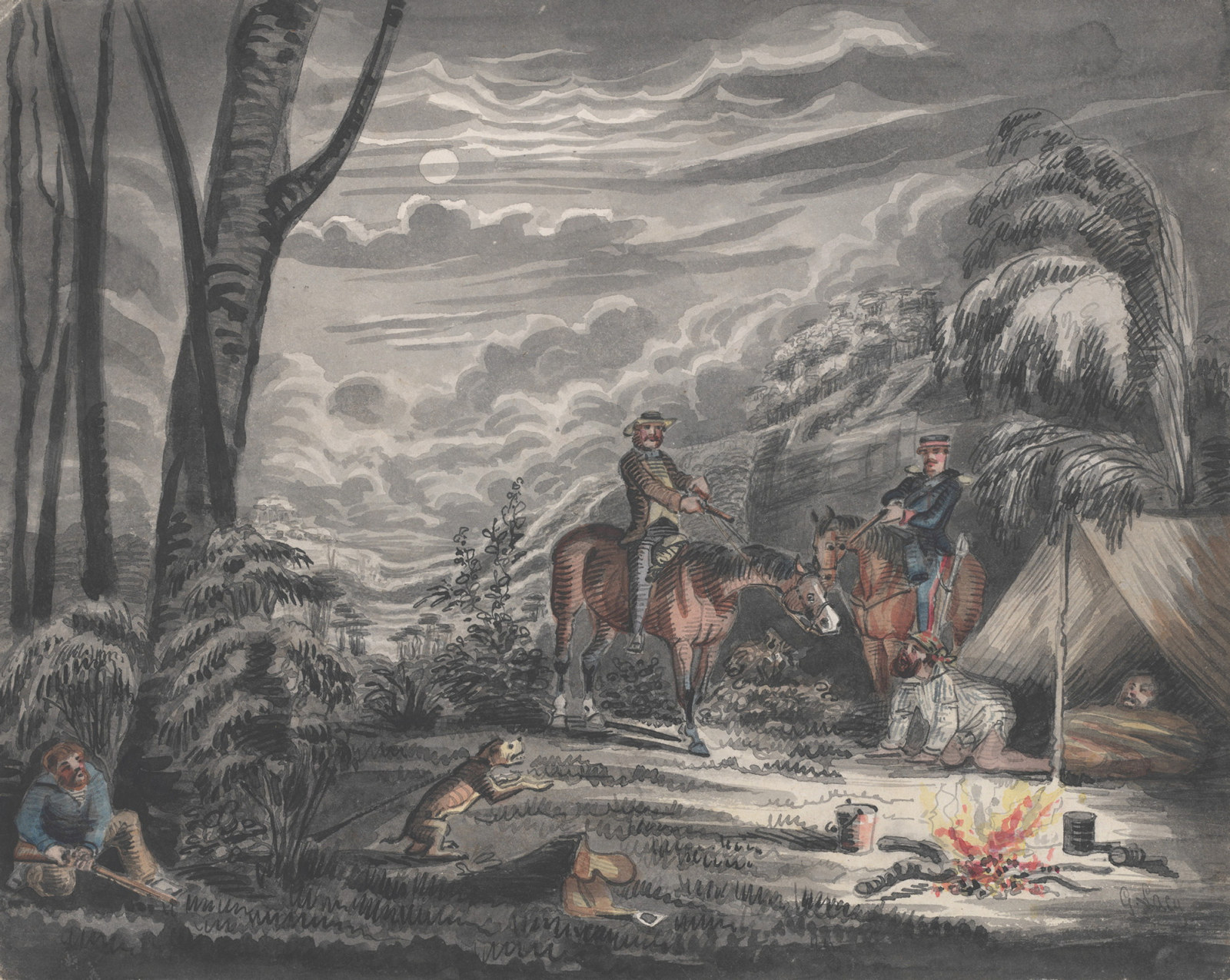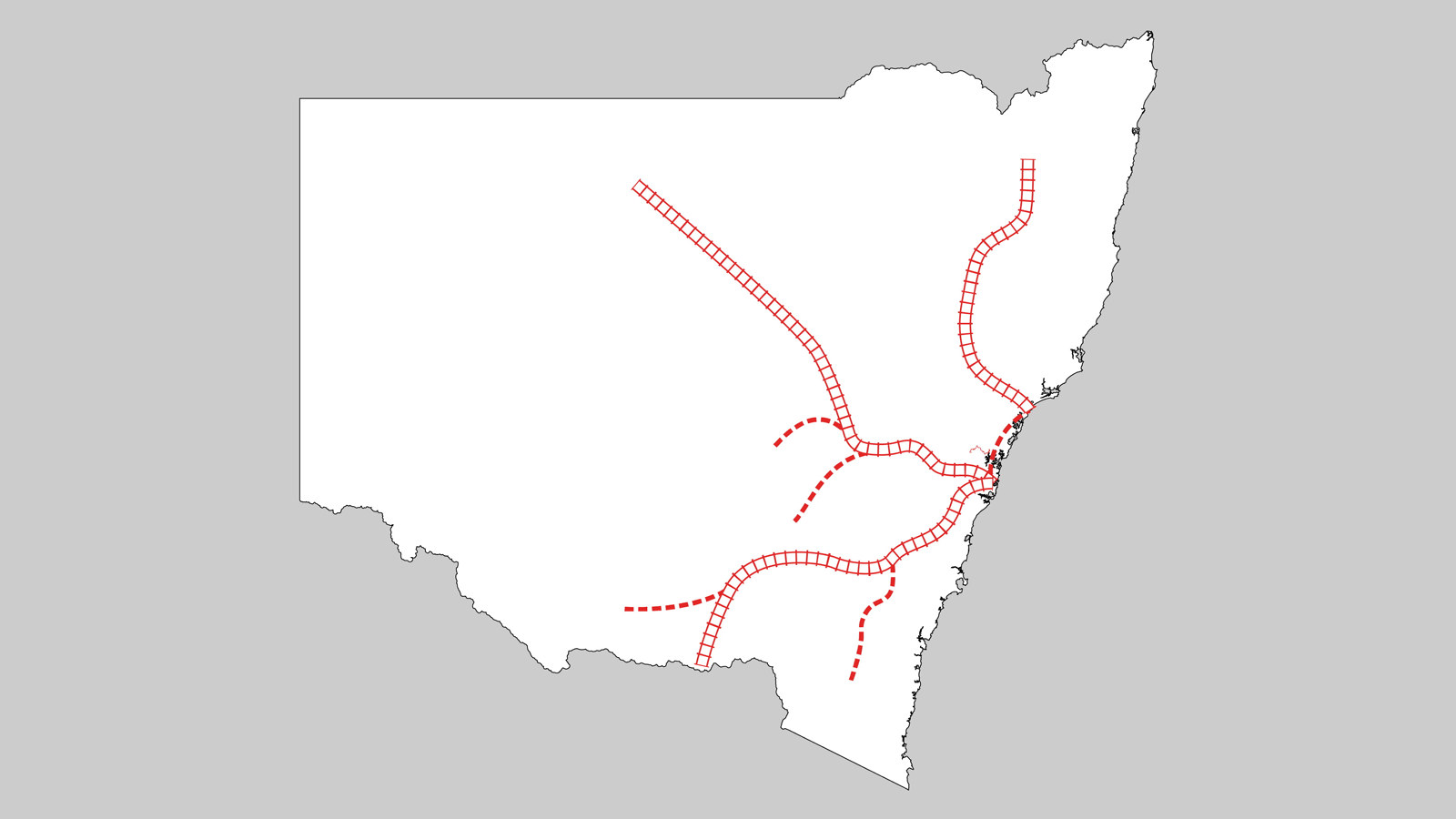Troopers & Aboriginal trackers
What was it like to be in the mounted police?
Police worked hard to maintain order during the gold rush. Gangs of bushrangers made their job even more dangerous.
When the gold rush started in 1851, the police were given the job of safely escorting the gold from the goldfields to the towns.
This new job was dangerous because of the threat posed by bushrangers.
Throughout the 1850s the work of police increased, as more and more goldmining towns were established. So in 1862 the NSW Government passed a law (the Police Regulation Act), that tried to improve the police force:
- All police units were placed under one command, based in Sydney.
- New police stations were established around NSW (80 between 1855 and 1865).
- New men were recruited (more than 1000 between 1862 and 1871).
These steps helped the police to do their job as the population of NSW continued to grow, particularly in rural areas where goldmining occured.
Who were the police?
During the 1850s, most of the men in the NSW police force had emigrated from the United Kingdom, where they had worked as policemen.1
But after 1862 this started to change.
After 1862, it also became harder to join the police. Recruits needed to be under 30 years old (previously it had been 40), be fit and healthy and have these personal attributes:2
- discretion
- intelligence
- decision-making skills
- a perfect temper
- trustworthinessy.
Once accepted, a recruit spent three months at the police depot in Sydney, where they learned to shoot, march and to ride a horse. They were also encouraged to practise their reading and writing, because being able to communicate well would help them to earn promotions to higher ranks.
The best recruits were assigned to the NSW mounted police - an elite unit. These men were known as 'troopers'.
Meet some of the men who served as troopers during the gold rush:
What did a trooper's job involve?
Troopers were responsible for protecting people in the most isolated parts of the colony.
On any given day they might have to deal with:
- break-ins;
- fraud and forgery;
- assault and murder;
- finding escaped prisoners;
- arson;
- animal theft; and
- catching bushrangers.
Alcohol was also causing significant problems in the colony during the gold rush.
For example, between 1870 and 1880 the number of people arrested for 'being drunk' tripled.3
As well as having to confront criminals, troopers risked injury and physical hardship in the harsh bush environment.
For example, a man could break an arm or a leg in a riding accident. And exposure to harsh weather conditions could lead to illness or heatstroke - both of which could be life-threatening if not treated quickly.
So while out on patrol, troopers had to carry water, medicine and other supplies.
What skills did a trooper need?
To be a successful trooper a recruit would need to develop specific skills and knowledge, such as:
- excellent horseriding skills;
- learning how to care for a horse; and
- knowing the roads, geography and people in their district.
During the early 1860s, bushrangers had an advantage over the new recruits.
Many of the recruits had come from the London or Irish police force, so they had little experience of riding and no bush skills.4
By contrast, most bushrangers were Australian-born and had grown up in the country.
They knew the land, were good horsemen and could live in the bush comfortably.
However, the new troopers slowly gained experience and fought back. As a result, more than 400 bushrangers were arrested during the 1860s.5
To help them with their job, troopers also relied on the skills from another elite group within the NSW Police - Aboriginal trackers.
Main duties of the mounted police
Escorting
Gold and other valuable items, as well as prisoners, needed to be moved from town to town. During an escort, the troopers kept their weapons loaded and ready to use at all times.
Patrolling
Troopers patrolled their districts to try to prevent crime. Districts might cover hundreds of square kilometres of rough terrain, and were occupied by thousands of people.
Retrieving stolen animals
Theft of animals (like sheep or cattle) was a common crime during the gold rush. Troopers were able to search the bush on horse, covering more territory more quickly. In one instance they returned 1000 sheep to an owner - before he had even realised out that they had been stolen!
The importance of Aboriginal trackers
When the NSW police force was reorganised in 1862, the role of 'Aboriginal tracker' was included as an official position.6
With a deep knowledge of Country and invaluable skills in observation, trackers helped police navigate harsh and unknown environments to catch criminals - from cattle thieves to bushrangers.
Sometimes they tracked them for days, over hundreds of miles.
Trackers worked with the troopers to catch some of the worst bushrangers, including Ben Hall and the Clark brothers. For their assistance they also received a share of the rewards.
Some criminals even boldly claimed that without trackers, the police were not actually a threat!7
But despite their obvious value and skill, Aboriginal trackers were paid less than half of what a trooper earned for a day's work.8 9 10
To realise the wonderful skill of these trackers [you] need to consider the nature of the country over which they work.11
As well as helping the police, Aboriginal trackers were also relied on to find people who got lost in the bush - including very young children.
During the gold rush the trackers were acknowledged as being highly skilled experts, courageous, dedicated and incredibly valuable to the police force.
They also showed resilience, looking for new opportunities to apply skills that had been passed down to them through previous generations.
However, it's important to acknowledge that many Aboriginal trackers were also treated poorly and experienced discrimination while serving in this important role.
History skills: source analysis
Many primary sources praise the skills of Aboriginal trackers, but also contain negative perspectives (including words and images). So you need to read them carefully, consider the historical context in which they were written, and think about what they can teach us today, about the past. This is one of the important jobs a historian has.
For further information about Aboriginal trackers in NSW, including personal stories, visit Pathfinders
What equipment did they have?
Troopers were issued with a long list of equipment, and had to pay for anything that was damaged through neglect.
Mounted police equipment in 1862
- a horse
- a saddle and bridle
- weapons and ammunition
- rations
- a full uniform (including waterproof cape)
Unfortunately, the troopers' uniform meant bushrangers could identify them from a long way away. So they were sometimes given permission to patrol in plain clothes.
Troopers carried a wide range of weapons when out on patrol
Caring for a police horse
A horse was the most precious asset that a trooper or a tracker had.
Because they relied on each other, man and horse would have formed a strong bond.
Both were required to take great care of their horse at all times, making sure that:
- the horse was well fed (mainly with hay) and watered;
- the horse got plenty of rest when not on patrol; and
- equipment such as horseshoes, saddles and straps was kept in good condition.
If a trooper did not take proper care of his horse, he could be kicked out of the unit and reassigned to the foot police.
This would have been quite a demotion for an elite mounted trooper.
No speeding...(unless you're chasing a bushranger)!
'No horse is to travel faster than 8 kilometres per hour, unless in [an] emergency, such as [chasing] an offender.'
Rules for the Police Force of New South Wales, 1862, Rule 308 [Horses]
What dangers did troopers face?
Being in the mounted police was a dangerous job. Troopers could be:
- injured or killed in an accident;
- suffer emotional stress from work-related incidents.
Horseriding was a particularly risky part of their job and accidents did happen.
For example, in 1853 Trooper John Nichol was killed after he fell from his horse while chasing bushrangers.12
Other men drowned in flooded rivers or became gravely ill while on duty.
If a trooper was badly injured, or killed, while working, his family was able to receive a pension (money) to help make ends meet.
Fighting against bushrangers
To track down bushrangers, troopers relied on information from private citizens, the work of Aboriginal trackers and their mounted patrols.
But trying to arrest a bushranger could be dangerous. Between 1862 and 1880, bushrangers killed at least 13 mounted troopers and policemen.
One of these men was Constable Edward Webb-Bowen. He was killed in November 1879 during a shoot out with a gang of bushrangers that included Captain Moonlite.
Webb-Bowen left behind a wife and a young son.
Luckily for police, the gold rush also saw the arrival of new technology, including the electric telegraph and the railways.
Both had a significant impact on the ways in which the police were able to fight back against bushrangers.13
Activities
Footnotes
- ‘Police Regulation Act of 1862 – report on working of’, New South Wales Police Annual Report 1872, 4 June 1872.
- ‘Police Rules’, New South Wales Government Gazette, 1 March 1862, no 49, p476.
- New South Wales Police Department annual report for 1880–81.
- ‘Bushranging and our police system’, Empire, 28 November 1867, p6.
- S West, ‘The role of the “bush” in 1860s bushranging’, Journal of the Royal Australian Historical Society, vol 91, part 2, December 2005.
- New South Wales Government Gazette, 1 March 1862, no 49, p476.
- New South Wales Police Gazette and Weekly Record of Crime, 22 December 1869, no 51, p398.
- ‘The Estimates for 1862’, The Maitland Mercury and Hunter River General Advertiser, 26 October 1861, p6.
- The Sydney Morning Herald, 10 May 1865, p3.
- Empire, 2 October 1867, p2.
- The Lone hand, 'The black trackers', B Bowyang. 1 February 1821, p24.
- ‘The western goldfields’, Empire, 30 March 1853, p3.
- ‘Police Regulation Act of 1862 – report on working of’, New South Wales Police Annual Report 1872, 4 June 1872.
Published on
More
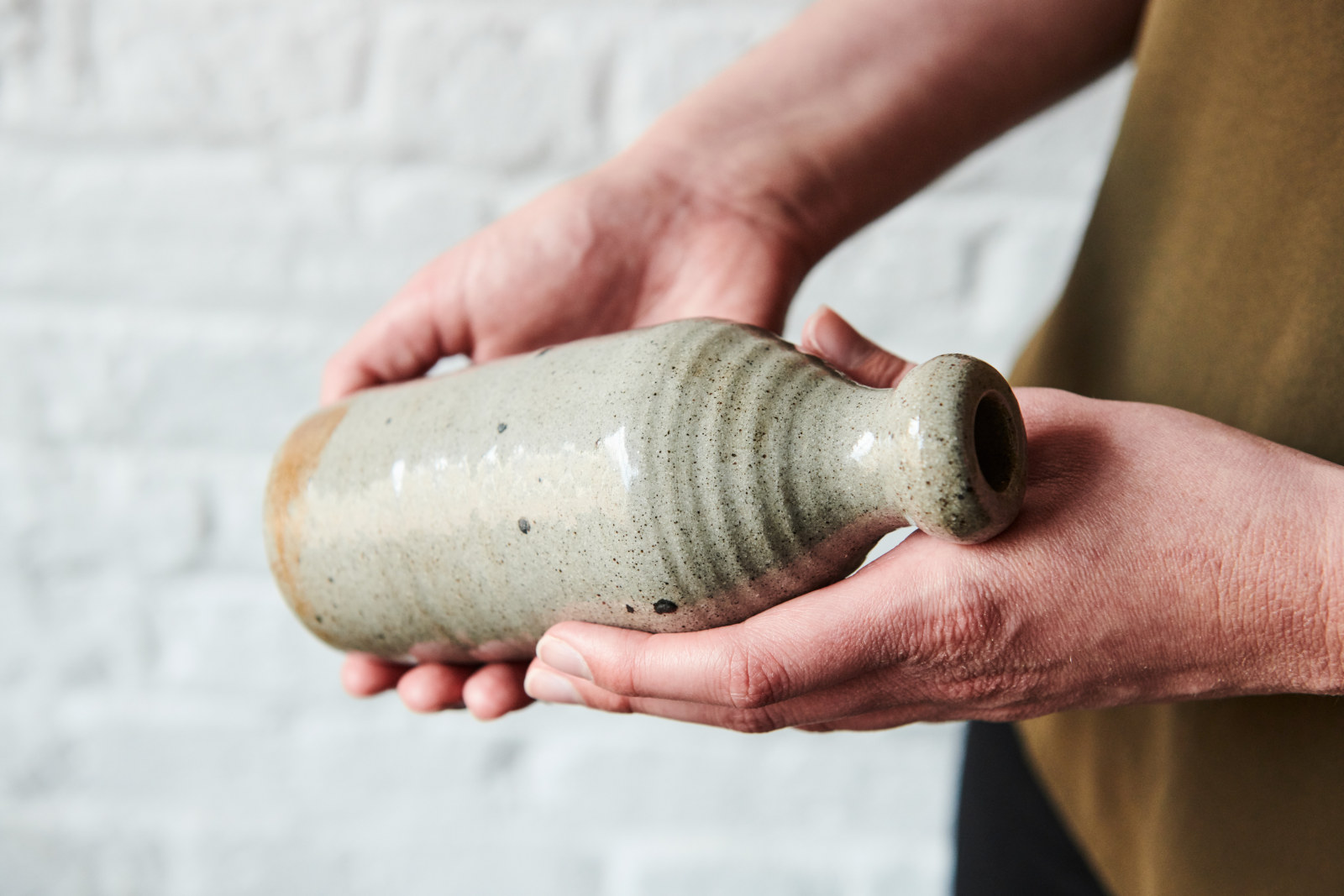
Learning resources
Explore our range of online resources designed by teachers to support student learning in the classroom or at home
